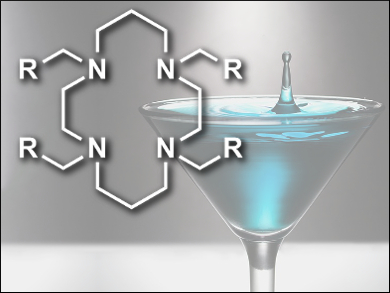Tetraazamacrocycles can bind a wide range of metal cations, can be functionalized to tune their properties, and have applications, e.g., in medicine, in catalysis, and in fluorescent probes. One way to significantly change their behavior as a ligand is N-tetraalkylation. While there is a robust reaction for the synthesis of N-tetramethyl derivatives, other alkylations are more difficult and can suffer from low yields or limited scope.
Matthew H. Todd, Peter J. Rutledge, and colleagues, University of Sydney, Australia, have developed a high-yield direct method for the N-tetraalkylation of the azamacrocycles cyclam and cyclen. The team used a partially miscible aqueous-organic solvent system (aqueous sodium hydroxide and acetonitrile) to react electrophiles such as propargyl bromide or benzyl bromides with cyclam and cyclen. The desired tetraalkylated products (example pictured) were obtained in good to excellent yields as a fine precipitate at the phase border between the two solvents.
The reaction has higher yields when the reaction mixture is shaken instead of stirred (74 % compared to 52 % for the reaction of propargyl bromide and cyclam). While this effect has been seen in other reactions, there is no comprehensive explanation for it. The researchers propose that the mechanical motion could influence nanostructure formation in the precipitate or cause cavitation effects, but they point out that further work is needed to fully explain the effect.
- A direct method for the N-tetraalkylation of azamacrocycles,
Andrew J. Counsell, Angus T. Jones, Matthew H. Todd, Peter J. Rutledge,
Beilstein J. Org. Chem. 2016, 12, 2457–2461.
DOI: 10.3762/bjoc.12.239




